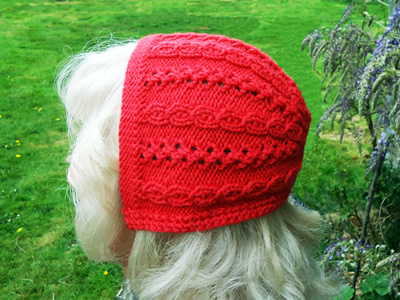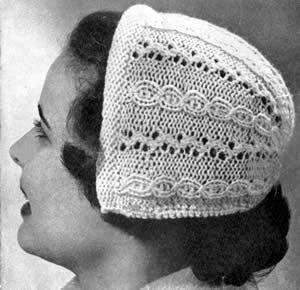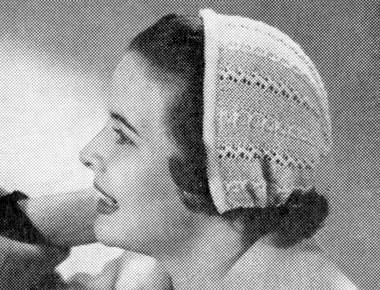Easter Bonnet

This type of bonnet was very popular in the 1950s - at least it was much favoured by Paton and Baldwin, using their Fuzzy Wuzzy angora**. I think, following the 1940s roll, it went with the more modern shorter hairstyles, and was possibly the half-way house to what was essentially the demise of the hat for everyday wear. Anyway - I am sure they explored every possible variation on this basic style.
**Perhaps not the best marketing brand for today's knitters.... However, angora wool is very light weight and was sold in half ounce balls; this gives you the clue that it was relatively expensive, so a tiny little cap - or perhaps bolero - was ideally affordable. (And did I mention fluffy? even I - never allergic to anything - am prone to fits of sneezing when wearing angora).
Note that there are two versions of the bonnet for different yarn weights.
Instructions for the double knitting bonnetPattern stitch is worked over 6 rows: 1st row (right side facing): *
p3, k3, p3; leave wool forward (wfd), k2tog; repeat from *
to last 9 sts; p3, k3, p3. [Editor's note: The above pattern repeat of 6 rows is as given in the original instructions. If you compare the photo below with my version, you will see the eyelet arrangement is slightly different between the two. I worked (k2tog, wrn) and then (wrn, k2tog) alternately on the right side rows; this does not fit with the 6 row repeat of the mock cables. I have not written out my resulting 12 row repeat for you, but if you want to do this it is quite simple to keep track of the two patterns as you knit, one having a 4 row repeat, and the other, a 6 row repeat. Knit to the correct number of rows overall, and make sure you keep it consistent when you get to the decrease rows. ]

To Make:Cast on cast on 64sts using the knit cast-on method to give a loose edge.
Work 9 rows in stocking stitch (one row knit, one row purl), ending with
a knit row. Now make the hem for the hair-band casing as follows: Hem row (purl side facing, which is the
right side of the work): Fold the hem so that the cast on edge
is aligned at the back of the needle containing your working sts; *
knit one stitch on the needle with one loop from the cast on edge; repeat
from * to end. Now commence the pattern - work the 6 pattern rows five times. Start the shaping: 31st row (first shaping row): p3,
k3, p3; * leave wfd, k2tog, p2tog,
p1, k3, p1, p2tog; repeat from * to
last 11sts; leave wfd, k2tog, p3, k3, p3. [56sts] 37th row (second shaping row): p3,
k3, p3; * leave wfd, k2tog, p2tog,
k3, p2tog; repeat from * to last 11sts;
leave wfd, k2tog, p3, k3, p3. [48sts] 43rd row (third shaping row): p3,
k3, p3; * leave wfd, k3tog, k2, sl1,
k1, psso; repeat from * to last 11sts;
leave wfd, k2tog, p3, k3, p3. [40sts] Next row: Cast off 9sts; knit to
the last 9sts; cast off 9 and fasten off. To CompletePin out and press the work lightly on the wrong side with a warm iron
over a damp cloth. With the right side of the bonnet facing you, join the wool to one side
edge, at the inner edge of the hem (ie do not crochet the ends of the
hem together, as you need to thread your plastic hair band into it), and
work one row of double crochet all around the neck edge, finishing atthe
same position on the opposite side of the front. Draw the edge in slightly
as you work. Slip the hair band through the front casing, and then seam the short ends to close it off. Sew in and neaten all ends. |
MaterialsOriginal materials called for: 2 ozs double knitting wool. One pair of No 7 (4½mm) needles. One No 11 (3mm) crochet hook. 1½ yards elastic thread. A plastic hair band. Tension21 sts and 29 rows to 4 inches. Size mattersTo fit "an average head". Abbreviationsinc: increase by working into the front and back of the next stitch. dc: double crochet. A word on the wool.Original yarn Sirdar Majestic. I used Phildar Partner 6 in a lovely red shade, (50% nylon, 25% wool,
25% acrylic).
Disclaimer
|
Here is the same bonnet in a finer yarn. Normally, I would say finer yarns make a better result, (I know: "it depends"...). However, I actually prefer the double knit version of this style which seems better proportioned.

Instructions for the 3-ply bonnetPattern stitch is worked over 6 rows: 1st row (right side facing): *
p5, k3, p5; leave wool forward (wfd), k2tog; repeat from *
to last 13sts; p5, k3, p5. To Make:Cast on cast on 103sts using the knit cast-on method to give a loose
edge. Work 11 rows in stocking stitch (one row knit, one row purl), ending
with a knit row. Now make the hem for the hair-band casing as follows: Hem row (purl side facing, which is the
right side of the work): Fold the hem so that the cast on edge
is aligned at the back of the needle containing your working sts; *
knit one stitch on the needle with one loop from the cast on edge; repeat
from * to end. Now commence the pattern - work the 6 pattern rows eight times. Start the shaping: 49th row (first shaping row): p5,
k3, p5; * leave wfd, k2tog, p2tog,
p3, k3, p3, p2tog; repeat from * to
last 15sts; leave wfd, k2tog, p5, k3, p5. [93sts] 55th row (second shaping row): p5,
k3, p5; * leave wfd, k2tog, p2tog,
p2, k3, p2, p2tog; repeat from * to
last 15sts; leave wfd, k2tog, p5, k3, p5. [83sts] 61st row (third shaping row): p5,
k3, p5; * leave wfd, k2tog, p2tog,
p1, k3, p1, p2tog; repeat from * to
last 15sts; leave wfd, k2tog, p5, k3, p5. [73sts] 67th row (fourth shaping row): p5,
k3, p5; * leave wfd, k2tog, p2tog,
k3, p2tog; repeat from * to last 15sts;
leave wfd, k2tog, p5, k3, p5. [63sts] 73rd row (fifth shaping row): p5,
k3, p5; * leave wfd, k2tog, k1, k3tog,
k1; repeat from * to last 15sts; leave
wfd, k2tog, p5, k3, p5. [53sts] Next row: Cast off 13sts; knit to
the last 13sts; cast off 13 and fasten off. To CompletePress and complete as for the double knitting version of the bonnet. |
MaterialsOriginal materials called for: 1oz of 3-ply fingering wool. One pair of No 11 (3mm) needles. 1½ yards elastic thread. A plastic hair band. Tension30 sts and 44 rows to 4 inches. Size mattersTo fit "an average head". Abbreviationsinc: increase by working into the front and back of the next stitch. dc: double crochet. A word on the wool.Original yarn Sirdar Majestic. Disclaimer
|
